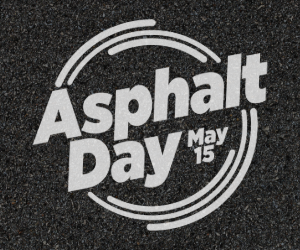Polyphosphoric acid, otherwise known as PPA in our industry, is a liquid mineral polymer additive used either by itself or in conjunction with other polymers. The benefit of using PPA is to increase a binder’s high-temperature PG grade and performance without diminishing its low-temperature grade and performance. The typical PPA dosage rate is between 0.25 percent and 1.5 percent by weight of asphalt. PPA is classified as a chemical modifier because it reacts with some of the components of the asphalt.
The use of PPA to modify asphalt has grown in the past decade, as has the use of other polymer modifiers. Some estimate that anywhere from 5 to 15 percent of the asphalt pavements placed in the last five years contained PPA in the binder. This increased use has also brought about a higher level of interest and concern regarding PPA modification. There are questions and some misconceptions about PPA that industry has been trying to address through education and research activities.
Recent Workshop
To help agencies make the most informed decision, the latest factual information and research was presented at a national workshop on PPA Modification of Asphalt held April 7-8 in Minneapolis, MN. The workshop was jointly sponsored by the Transportation Research Board, Federal Highway Administration, Minnesota Department of Transportation, TERRA, Association of Modified Asphalt Producers, Innophos Inc., ICL Performance Products LP and the Asphalt Institute. John D’Angelo from FHWA led the planning committee while MNDOT was the host. All speaker presentations (both slides and videos) are now available for public viewing at: https://engineering.purdue.edu/NCSC/PPA%20Workshop/2009/index.html.
Representatives of approximately 10 states were present along with many industry representatives. Hopefully more individuals will view the comprehensive talks and interactive discussions that occurred online. The website offers the most comprehensive and state-of-the-knowledge compilation of information regarding PPA modified asphalt. Presentation topics included:
- DOT Perspective (Survey Results)
- AI’s publication on PPA
- Industry Perspective
- Effects of PPA on Binder Properties
- Detection, Quantification, Recovery Issues
- Mix Performance Testing
- Moisture Damage
- Aggregate Type/Gradation
- Case Studies from NCAT, Arkansas, Ontario, Utah, MnRoad
- Industry Best Practices
There was also a panel discussion and interactive discussions throughout the workshop between agencies and suppliers. TRB hopes to publish a circular of papers from the workshop.
Other Technical Publications
If you can’t devote eight-plus hours to watch the on-line presentations and discussion, there are other outstanding technical references on the topic of PPA Modification. The PPA Subcommittee of the Phosphate Forum of Americas has recently produced two pamphlets: Best Practices for PPA Modification of Asphalt (7 pages) and Use of Polyphoshoric Acid in Asphalt Binders (13 pages). These excellent publications were written by two Asphalt Institute Members, ICL Performance Products LP and Innophos Inc, and can be obtained by contacting one of them.
Another excellent resource is the Asphalt Institute’s publication IS-220, Polyphosphoric Acid Modification of Asphalt (15 pages). While published in 2005, the recommendations for both suppliers and agencies are still very appropriate. It also has a section of “frequently asked questions” (and answers).
Addressing Agency Concerns
Some state agencies have no restrictions regarding the use of PPA modified asphalt. Others ban it altogether in their specifications and others have a more middle-of-the-road approach. There have been several surveys of state material engineers in the past few years asking if and how their specifications address the use of PPA and what concerns they may have. The most recent survey that was performed in preparation for the workshop is summarized in the first presentation titled “DOT Perspective.”
One reason an agency may place restrictions on PPA is that they want to ensure they have elastomeric behavior for their polymer modified PG grades. An all-out ban on PPA, however, does not allow suppliers to use even a small amount of PPA as a catalyst with SBS or ethylene terpolymer modification. In combination, there is a synergistic effect between the SBS and PPA, resulting in improved networking and overall better performance (stiffness and elasticity) than could be achieved by using SBS or PPA alone. The same type of synergy occurs with PPA and ethylene terpolymer that cannot be achieved by using only one or the other. This synergy was demonstrated at the workshop by several presenters.
To ensure a certain level of elasticity without prohibiting PPA, the agency can rely on “PG-Plus” tests, such as Elastic Recovery (AASHTO T 301). Using the new Multiple Stress Creep Recovery (MSCR) test, proposed as Table 3 in AASHTO M-320, in conjunction with a specified minimum Percent Recovery is an ideal way to ensure a desired level of elasticity in the supplied binder.
Another reason agencies have restrictions on PPA is centered on the possible chemical neutralization that may occur between the acidic PPA and other alkaline mix components such as lime or liquid anti-strips (LAS). Whether these interactions occur, and to what degree, seems to be dependent on the asphalt source as well as the chemical composition of the other additives. For example, the use of amine-based LAS with PPA modified binder may lead to partial neutralization of either the high-temperature gain obtained from the addition of PPA or the anti-stripping benefits obtained from the addition of the LAS. However, using a phosphate ester LAS should result in no neutralizing effect because phosphate esters are not amine based.
Chemical Dependency
How PPA reacts with asphalt and its effect with other mixture additives is very dependant on the asphalt crude source because different crudes mean different chemical composition. This can be illustrated by looking at the degree of high-temperature improvement obtained from a given dosage of PPA. Where one asphalt may hypothetically only need 0.5 percent to increase the high temperature PG grade from 64 to 70, an asphalt with the same PG grade but different crude slate may need 1 percent PPA to see the same level of improvement. It should also be noted that there are different concentrations of PPA that have different effects, with the most common concentrations being 105 percent and 115 percent.
This “chemical dependency” means that the absolute answers and assurances that agency material engineers seek can be difficult to provide. Another uncertainty that is being explored is the effect of aggregate type on PPA modified binders and mixture performance, both in the lab and field. Ongoing research by FHWA, MnROAD, industry suppliers and others is addressing these research needs.
Performance Testing Is the Answer
A predominant theme throughout the workshop was that the best way to ensure compatibility with all components is mix performance tests. These include the Hamburg Wheel Tracking Device (for rutting and moisture sensitivity), the Asphalt Pavement Analyzer (for rutting) and AASHTO T283 TSR (for moisture sensitivity). By performing these tests on the mix containing all actual components, they should identify poor performers and detect any compatibility issues between the PPA, lime, LAS, etc.
Simple binder testing can also detect any compatibility issues between a LAS and PPA modified binder. Comparing DSR binder stiffness with and without the LAS will detect if any neutralization is occurring and whether it is significant enough to fall out of spec. Using a phosphate ester LAS should prevent this. Binder elasticity requirements can be confirmed with the new MSCR test or with the Elastic Recovery test.
In Summary
PPA is one of many additives to modify and enhance paving grade asphalts. The correct use of PPA, in the appropriate amount, can improve the high temperature physical properties of the binder and overall field performance. The biggest concern among agencies is that the increased binder stiffness obtained by using PPA may not be permanent if it is partially neutralized by amine-based LAS or hydrated lime.
There is also concern that the improved moisture resistance obtained by adding hydrated lime or LAS to a mix may be partially negated by the PPA. To address these concerns, binder testing should be performed with the LAS additive and mixture tests should be performed with all additives. Incorrect application of PPA, like with any additive or modifier, can result in diminished field performance.
| IS-220 Polyphosphoric Acid Modifcation of Asphalt Price: $30.00 This publication provides information to user agencies, consultants, contractors, and suppliers on the use of polyphos-phoric acid (PPa) to modify paving grade asphalt binders. The goal of the publication is to clarify issues regarding PPa modi?cation and to help agencies make informed decisions regarding its use. 15 pages. available online. |














